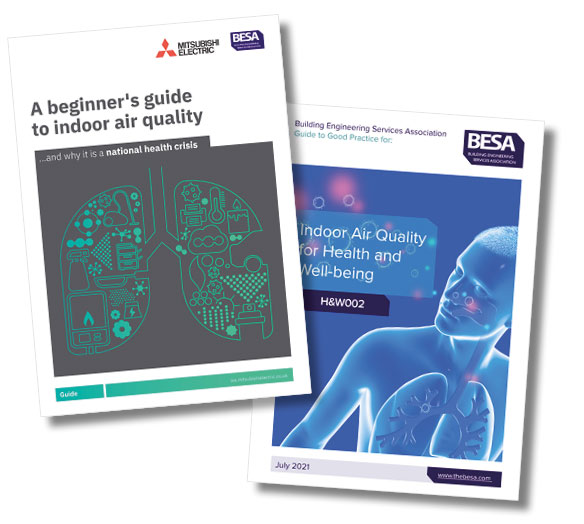The Building Engineering Services Association (BESA) has completed its trilogy of free guides designed to help building owners and managers turn their buildings into ‘safe havens’ that protect occupants from health risks linked to airborne contaminants and viruses.
‘Buildings as Safe Havens – a practical guide’ is the third in its suite of guidance for measuring, monitoring, and improving indoor air quality (IAQ) and the second produced with the support of Mitsubishi Electric.
The ‘BASH’ Guide offers practical steps that facility managers and building owners can take to measure indoor air quality (IAQ) and offers advice on the questions to ask ventilation experts.

The foreword is provided by one of the UK’s most respected experts on infection resilience in buildings, Professor Cath Noakes OBE. She states that poor ventilation is the most overlooked building safety issue and can be directly linked to high levels of Covid-19 transmission.
“Covid-19 has been shown to be transmitted through the air. Even if only 10% of all Covid-19 related deaths in the UK could be directly attributed to the failure to adequately ventilate indoor spaces, that would be more than 15,000 since the start of the pandemic – a shocking statistic that should make everyone sit up and take notice,” she writes in her foreword.
“The pandemic has demonstrated that far too many of our buildings are under-ventilated, despite regulatory requirements that have been in place for a number of years. This guide will be an invaluable tool in raising awareness of the importance of good IAQ and making our buildings more infection resilient,” says Noakes, who is Professor of Environmental Engineering for Buildings at the University of Leeds and a member of the government’s Scientific Advisory Group for Emergencies (SAGE).

Strategies
The new BESA guide provides a step-by-step strategy for monitoring and maintaining good IAQ in offices, schools, and public buildings and provides advice and strategies for dealing with ventilation problems. It outlines the questions building managers should ask their ventilation and air quality specialists so they can properly address their IAQ problems, and provides recommendations for conducting a building review, planning for improvements, and selecting the right technology.
The contents of the guide were steered by a technical committee led by Nathan Wood, chair of BESA’s Health and Wellbeing in Buildings group, and the Association’s head of technical Graeme Fox.
The guide contains a building review spreadsheet to help building managers identify areas that require improvement. This is designed on a traffic light system, with actions categorised as red, amber, and green, and works in tandem with an IAQ monitoring spreadsheet.
“Most buildings do not have any active ventilation management,” says Wood. “At the top end of the market, the issue is well understood, and expertise is on hand to put best practice into effect, but our priority now is to find ways of helping the thousands of buildings that have no ventilation strategy and lack the information and expertise to prepare for
the next health emergency.
“That is why BESA is working hard to raise awareness and provide free guidance that can improve competence and compliance across the ventilation industry – and broaden the pool of ventilation expertise to take on this massive task.”
Hern Yau, Ventilation Product Specialist at Mitsubishi Electric, added that the pandemic had emphasised the importance of ventilating indoor spaces.
“This guide will help contribute to a greater understanding of the type of equipment available, as well as encouraging more productive conversations about what can be achieved in our buildings in the long-term,” he added. “It also reinforces the importance of building managers only working with properly trained and competent IAQ specialists.”
 All three BESA guides addressing indoor air quality (IAQ) can be downloaded for free from: www.theBESA.com/iaq
All three BESA guides addressing indoor air quality (IAQ) can be downloaded for free from: www.theBESA.com/iaq
This is the third in the BESA suite of independent, free guidance for measuring, monitoring, and improving indoor air quality (IAQ) and the second produced with the support of Mitsubishi Electric.
The first is ‘A Beginners Guide to Indoor Air Quality’ published in collaboration with Mitsubishi Electric, which was produced in the wake of a report commissioned by the government’s chief scientific adviser Sir Patrick Vallance, which highlighted the importance of building ventilation in reducing the risk of Covid-19 and other infections.
The Beginners Guide was supported by of one of the UK’s most high-profile child health campaigners, World Health Organisation (WHO) advocate Rosamund Adoo Kissi-Debrah.
It offers advice and guidance for employees and visitors to commercial buildings and, with so many people now working from home, includes some easy tips for optimising IAQ in residential settings.
(www.thebesa.com/media/1409355/indoor_air_quality_guide.pdf?utm_source=Website&utm_medium=Technical&utm_campaign=IAQ%20Guide)
This was followed by a highly technical Guide to Good Practice from the BESA Health & Wellbeing in Buildings group, which sought to explore what technical expertise could be offered to improve indoor air quality for health and wellbeing.
(www.thebesa.com/media/1409649/iaq-guide-master.pdf)
The new Guide refers to established guidelines including those provided by the World Health Organisation (WHO), which are due to be updated later this year. It also signposts other sources of authoritative advice on volatile organic compounds, formaldehyde, nitrogen dioxide/oxides, ozone, radon, and airborne micro-organisms.
It also recommends monitoring CO2 and a range of IAQ factors to balance good air quality with reduction of internally and externally sourced contaminants.
Its guidance will also be offered to the BSI to help shape the draft BS40101 ‘Building performance evaluation of occupied and operational buildings’, which is due to be published in November and is currently the subject of a public consultation.
(www.thebesa.com/media/1410046/bash-guide-final-1pp.pdf)
- Log in to post comments















